Marie Maynard Daly
Dedicated at Columbia University on May 19, 2023
On June 3, 1947, on the campus of Columbia University in New York City, a young chemistry student from Queens received her Ph.D.
At the time, she didn’t know she was making history.
Working with Mary Letitia Caldwell, who was then the only female chemistry professor at Columbia, Marie Maynard Daly took less than three years to complete her thesis: “A Study of the Products Formed by the Action of Pancreatic Amylase on Corn Starch.” The work was a valuable contribution to research on how enzymes break down food, and it marked a historic turning point. The day that Daly successfully defended her thesis, she became Dr. Daly, the first Black American woman to earn a Ph.D. in chemistry in the U.S.
Contents
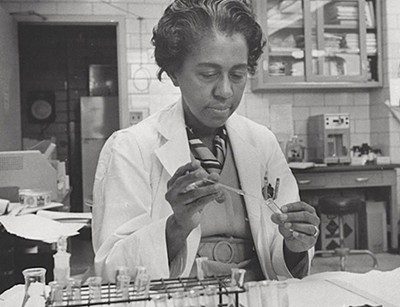
Little-known pioneer
With such a distinction, as well as a long and illustrious career of breakthroughs in biochemistry, the origins of certain diseases, and basic biological science, Marie Maynard Daly should be a household name. Unfortunately, while her employment and research activity can be gleaned from institutional and publication records, her personal history and what drove her to conquer racial and gender barriers are more difficult to piece together.
Marie was the firstborn child of Ivan Daly, who immigrated to Queens, New York, from the West Indies as a very young child, and Helen Page, who landed in New York early in life from Washington, D.C.
Both parents encouraged Marie’s interest in academics. Her father had almost become a chemist himself, starting an undergraduate degree at Cornell University in 1918. Unable to finish — most likely for financial reasons — Ivan returned home to the Corona neighborhood in Queens and worked as a clerk for the post office. He married Helen Page in 1920, and Marie was born the following year. After three more years, the family welcomed twin boys. They lived in a two-story house on tree-lined 32nd Avenue. Ivan played tennis and was the local club secretary. Helen spent a lot of time with the children. In a 1992 interview, Daly said that her mother read to her every night.
Her favorite book as a child, she recalled in the same interview, was the science blockbuster of the day, “Microbe Hunters,” by American biologist and author Paul de Kruif. The book follows the fascinating paths of 12 of the world’s most renowned researchers in the field of microbes. Like a mystery novel, “Microbe Hunters” uncovers the work of greats like Antonie van Leeuwenhoek, a Dutch scientist who discovered microbes, and French researcher Louis Pasteur and his discoveries about vaccines. The chapters have enticing titles — a definite draw for young audiences: Microbes are a Menace!; Microbes Must Have Parents!; Massacre the Guinea-Pigs; The Death Fighter.
It is a wonderful historical fact that Daly is the first [Black American woman to earn a Ph.D. in chemistry], but that is not why she matters.
She is important because of her contributions just like anybody else.”
— Jeannette E. Brown, African American Women Chemists, 2011
The allure of science
All the sleuthing scientists in “Microbe Hunters” were White men. Many were from distant locales and venerable institutions. There was no reflection of a young Black American girl from Queens in de Kruif’s lineup. But that didn’t deter Daly in the least. She was more interested in the hunt than in the hunters. Her inspiration was the scientific method, not the celebrities making the discoveries. Her motivation was to unlock secrets of the microscopic world that held the key to so many yet unsolved mysteries.
She embarked on this mission with gusto. Daly was accepted into Manhattan’s prestigious Hunter College High School for gifted girls. The four-story Gothic building with a tower, tall windows, and lots of light was a haven for academically driven girls like Daly. The school was unique because of its diversity and because its teachers focused on science, math, business, and medicine.
“The inclusion of African-American women within the College doors without mishap or fanfare distinguished the institution from others that admitted women,” wrote Linda M. Perkins in a 1995 history of the school. “The school was merit-based and open to students without regard to religious, racial, or socioeconomic background from the earliest years of its history, making it one of the most significant institutions in the history of the higher education of African-American women.”
Daly credited Hunter College High School, with its all-female faculty, for leaving no doubt in her mind that she would succeed as a scientist. When she graduated, the February 19, 1938, edition of The New York Age trumpeted her success. “Miss Marie Daly, daughter of Mr. and Mrs. Ivan Daly, is receiving congratulations of her many friends on her successful completion of Hunter College High School last week. Her general average for the term was 98 percent.”
While many of her fellow high school graduates went on to Hunter College for a bachelor’s degree, Daly opted for the brand-new campus of Queens College, a public university in the Flushing neighborhood of Queens. The student body was almost all White, but it was Daly’s academic skill that made her stand out.
“A Queens College Scholar and one of those elite persons on the Dean’s list,” wrote the yearbook editors, “Marie Daly has an enviable record. She is a Chemistry major and a member of the Chemical Society. In her chosen career as a laboratory technician, she bears the mark of one likely to succeed.”
In 1942, the year she graduated, it was definitely a compliment for a woman in chemistry to be told she’d have a successful career as a laboratory technician. However, her classmates underestimated Daly’s future achievements by a long shot.
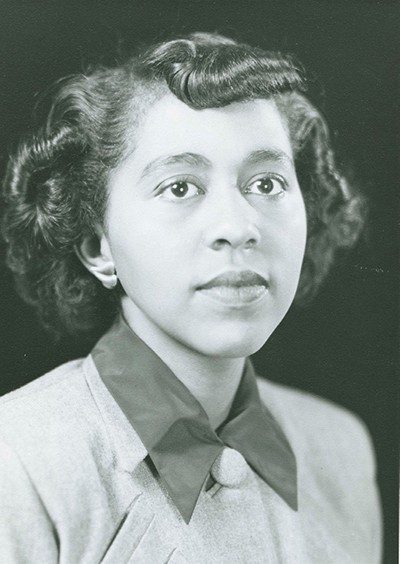
Drawn to research
Daly knew she wanted to go further than a bachelor’s degree so she could do actual research. But at the time, graduate school acceptance was rare for women. However, as World War II loomed for the U.S., fewer men were enrolling in universities, and in 1943 New York University began to admit an equal number of women and men. Daly finished her master’s degree at NYU in 1943 while holding a job teaching chemistry at Queens College.
Next, Daly was accepted as a graduate student by Columbia’s chemistry department in July 1944. Most universities at this time had only male professors, but Daly joined the lab of Mary Letitia Caldwell, Columbia’s sole female faculty member in the department. Caldwell was a celebrated researcher doing cutting-edge work on enzymes. “Many of the principles taken for granted in enzymology today were first applied to amylases in Caldwell’s laboratories,” Daly wrote in 1976. “In a series of distinguished, meticulous studies, [her team] showed that amylases were proteins and demonstrated which chemical groups were necessary for the activity of certain amylases.”
Mysteries were being solved. Daly was hooked.
Yet she was keenly aware of the sexism playing out at Columbia. “In those days, it was common for a woman to be addressed as ‘Miss’ even though she had earned a Ph.D. degree,” Daly wrote. While male colleagues in the chemistry department called Caldwell “Miss,” “her students always addressed her as D. [Doctor] Caldwell.”
After earning her Ph.D. in 1947, Daly briefly taught at Howard University, a historically Black university in Washington, D.C., until she landed a grant from the American Cancer Society. The money funded a post-graduate research position at Rockefeller University with Alfred Mirsky, one of the foremost geneticists of his time.
Daly told an interviewer in 1992 that Rockefeller, where she worked for seven years, was an “awesome and inspiring” place to be. Beyond her work researching the architecture of proteins with Mirsky — including the amino acid composition of histones, the proteins around which DNA is wrapped in cells — Daly partnered with several other top Rockefeller researchers to make groundbreaking discoveries and published six peer-reviewed articles. Her 1953 study with Vincent Allfrey and Mirsky showing that protein production requires RNA was cited in James Watson’s Nobel Prize lecture about DNA, RNA, and protein synthesis.
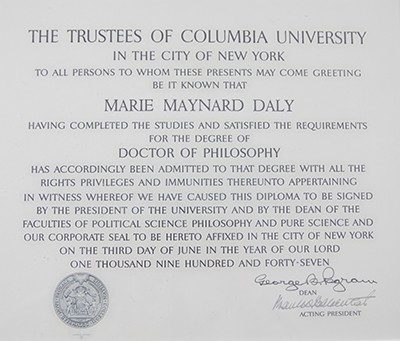
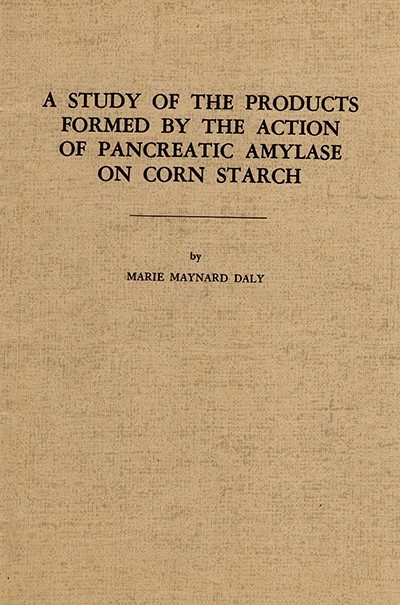
Change in focus
In 1955, Daly pivoted to medical research when she took a position at her alma mater and joined the Columbia University College of Physicians and Surgeons. Using lab rats, her team found important links among atherosclerosis, aging, and high blood pressure. Daly formed a close partnership with Quentin Deming, a medical doctor and heart disease researcher. The two continued their fruitful collaboration, with funding from the American Heart Association, when they took their skills to Albert Einstein College of Medicine (at the time, part of Yeshiva University) in 1960, just five years after it opened. Daly was hired as an assistant professor of biochemistry and was later awarded an associate professorship and tenure. She also held a position on the Health Research Council of New York between 1962 and 1972.
In photos from this time, wearing a white lab coat and surrounded by test tubes, beakers, and stacks of notebooks, Daly appears absolutely at home in her environment.
This was also an important time in her personal life: A month shy of her fortieth birthday, Daly married Dr. Vincent Clark, a physician with two children whom she became close to. The wedding took place in Greenwich, Connecticut. The couple did not have children together.
In 1975 Daly and Deming did ground-breaking research on the impact of diet and cholesterol on arteries in rats. They showed that the majority of those with a history of hypertension had an increased risk of experiencing a heart attack. Daly continued collaborating with many other researchers on topics including heart attacks, cholesterol, and the effects of smoking on lung health. Toward the end of her career, she returned to her first love — the study of enzymes. She published her last paper, as the sole author, in 1985, the year before she retired.
In those days, it was common for a woman to be addressed as ‘Miss’ even though she had earned a Ph.D. degree.”
— Marie Maynard Daly, American Chemists and Chemical Engineers, 1976
Second Columbia Landmark
The National Historic Chemical Landmark for Marie Maynard Daly is the second such designation at Columbia University. ACS awarded the university’s first Landmark for Havemeyer Hall, which was recognized in 1998 for the plethora of pioneering research that has been carried out in the building.
Overcoming adversity
While there are no known first-hand accounts by Daly concerning the racism and sexism she surely faced, we do know she joined forces with other women scientists of color in 1975 as a participant in a conference in Virginia hosted by the American Association for the Advancement of Science. The group reported on the inequalities faced by Mexican American, Black, Puerto Rican, Native American, and Asian women in science, and they discussed ways to improve the future for their own and later generations.
To help bolster diversity at Albert Einstein College of Medicine, Daly spearheaded an effort in 1968 to recruit, train, and support Black students. In 1988, Daly established a scholarship fund for Black science students at Queens College in honor of her father and mother.
Daly passed away on October 28, 2003, at the age of 82.
There is little record of how Daly felt about her own success in the field of biochemistry and medical research. Fortunately, in a tribute to her graduate advisor, we hear Daly’s warm sentiments about a woman with a life-long love for solving mysteries and a celebrated career in science: “During her last years, [Caldwell] must have looked back upon her productive career with a sense of achievement and with the satisfaction of knowing that the quality of her work had been recognized.”
We can well imagine that Dr. Marie Maynard Daly felt the same sense of satisfaction about her own achievements.
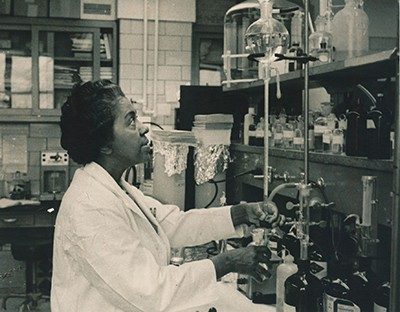
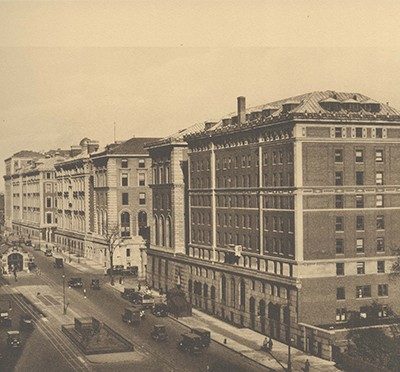
Landmark dedication and acknowledgments
Landmark dedication
The American Chemical Society (ACS) honored Marie Maynard Daly with the National Historic Chemical Landmark (NHCL) designation in a ceremony at Columbia University on May 19, 2023. The commemorative plaque reads:
In 1947, Marie Maynard Daly made history. The young Columbia University student from Queens, New York, became the first African American woman to graduate with a Ph.D. in chemistry in the United States. Daly took just three years to complete her dissertation under the guidance of Mary Letitia Caldwell, who was then the sole female professor in Columbia’s chemistry department. Their work made valuable contributions toward understanding how enzymes break down food. During Daly’s subsequent career, she published additional important research in biochemistry, the origins of some diseases, and basic biological science.
Acknowledgments
Written by Victoria Bruce.
The author wishes to thank contributors to and reviewers of this booklet, all of whom helped improve its content, especially members of the ACS NHCL Subcommittee.
The nomination for this Landmark designation was prepared by the New York Section of the ACS.
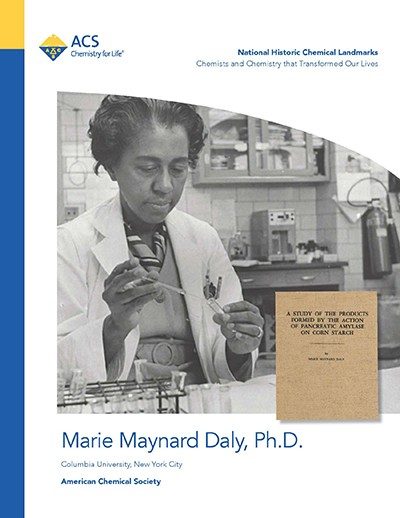
Booklet PDF

